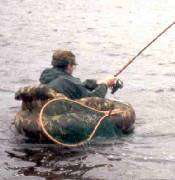Almadraba

etching by Jean-Pierre Houël, 1782.
Almadraba (Spanish "tuna fishing" or "netting fence to catch tuna")[1] is an elaborate and age-old Andalusian technique for catching Atlantic bluefin tuna that dates from Spain's Islamic period.[2]
The Spanish word almadraba is of Andalusian Arabic origin المضربة almaḍraba : 'a place to strike' < Arabic root ضرب 'to strike, hit'. Besides the region of Andalusia, it is also historically practiced in the southern Spanish regions of Murcia and southern Valencia, on the Mediterranean coast. A similar technique exists in Sicily known as mattanza (a borrowing from the Spanish word matanza, meaning slaughter), introduced either by the Spanish or by the Moors during Sicily's own Islamic period.
In film
- Roberto Rossellini's Stromboli includes documentary shots of the mattanza.
- Rupert Murray's The End of the Line (2009 film) demonstrates almadraba when discussing declining catches.
See also
- Barbate, town known for its Almadraba fishing.
- Favignana, a Sicilian island where mattanza is performed.
- The Dukes of Medina-Sidonia made their fortune on the monopoly of Andalusian almadrabas from the 12th to the 19th century.
- Zahara de los Atunes, an Andalusian town named after the tunas of its almadraba.
- Castle of Zahara de los Atunes and Palace of Jadraza
References
- ↑ almadraba Diccionario de la lengua española, Vigésima segunda edición, Real Academia Española, 2001. (Spanish)
- ↑ "Las almadrabes y Chiclana". Archived from the original on 27 June 2010.
This article is issued from Wikipedia - version of the 10/6/2016. The text is available under the Creative Commons Attribution/Share Alike but additional terms may apply for the media files.

